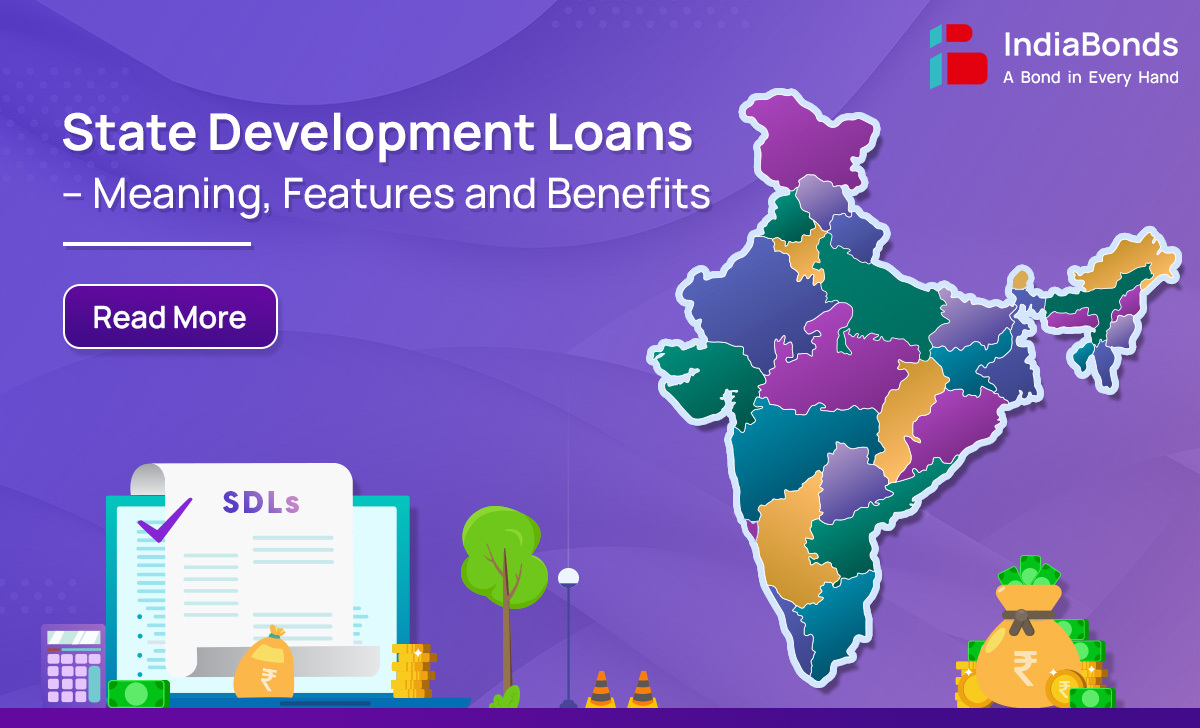What are State Development Loans – Meaning, Features and Benefits

In one of the previous articles, we learned about how the government issues g-secs to fulfill its fiscal requirements. Similarly, state governments issue bonds, commonly known as State Development Loans (SDLs), to meet their budgetary needs. State development loans are debt instruments issued by state governments in India to fund its developmental activities. In the past decade, there has been a sharp increase in the size of state government budgets and they now collectively spend significantly more than the union government. According to the RBI report, the market share of state development loans (SDL) outstanding has increased from 16.59% in 2008-09 to 29.06% in 2018-19. In this article, we will explore the features, benefits and investment opportunities associated with SDLs.
What are State Development Loans?
SDLs are also known as state government bonds or SDL Bonds. SDLs are regulated by the Reserve Bank of India (RBI) and are issued in the form of bonds. The maturity of these bonds is generally up to 10 years, but it ultimately depends on the issuer who can choose a different tenure. The payment of interest occurs every six months, while the repayment of the principal is made at the date of maturity. These bonds come with a “sovereign guarantee,” which means that they carry no credit risk. The debt is primarily serviced by the state’s tax collections and the primary investors in SDLs include banks, insurance companies, EPFO, corporates, mutual funds and individual investors. If an SDL were to default on the maturity date, the RBI has the obligation to repay the SDL holders. The amount paid will be adjusted by the central government against the amount due to the states from the centre. The issuance of securities by states is regulated by a yearly limit. State Development Loans (SDLs) are made available through standard auctions conducted by the RBI in the primary market, with trading in the secondary market. Investors are often drawn to SDLs because of the higher interest rates they offer compared to central government securities, providing investors with higher returns. The fiscal strength of a state is inversely proportional to the interest rate or yield it will need to pay while borrowing through SDLs. Therefore, states with better fiscal positions will attract lower interest rates. SDLs offer higher yields coupled with a sovereign guarantee, making them an attractive option for investors. With the recent rate hikes, now is an opportune time to invest in SDLs. If you’re considering investing in SDLs, IndiaBonds is a great place to start!
Features of State Development Loans
| Returns: | Predefined coupon rate; semi-annually higher than g-secs. |
| Safety: | SDLs have a sovereign guarantee, meaning they are backed by the government’s full faith and credit. |
| Face Value: | Rs. 100; However, the minimum investment is Rs 10,000 |
| Liquidity: | Tradable (Exchange & OTC); Can be sold in secondary markets; Possibility of capital gains (Market linked returns). |
| Held: | Demat Account; Exchange tradable |
| Lock in: | No Lock-in |
| Taxation: | Interest earned is taxable; No TDS is deducted from the interest earned |
| Loan/collateral: | Possible |




Benefits of State Development Loans
Sovereign Guarantee:
SDLs are issued by state governments and backed by RBI, which are considered to be safe and secure. As such, they offer a high level of safety and security to investors.
Higher Yield:
SDLs typically provide higher returns than government securities, making them an attractive option for investors seeking higher yields. At the same time less relatively risky than corporate bonds.
Liquidity:
SDLs are actively traded in the market, which means that investors can easily buy and sell them as per their requirements in the secondary market. There is no lock-in. Such an arrangement grants investors the advantage of both liquidity and flexibility.
Who should invest in SDLs
SDLs are appropriate for investors with a conservative approach, who are willing to assume a low to moderate level of risk. They are particularly suitable for those seeking a higher return than what is offered by government securities while still prioritizing safety.
How to invest in SDLs
The procedure to invest in state development loans online is very simple on IndiaBonds:
Signup:
To purchase State Development Loans online, the first step is to sign up on IndiaBonds.com
Complete KYC:
Complete your KYC online in less than 3 mins! There is no need to fulfill any paperwork or make any uploads.
Browse Curated Packs:
Browse the curated packs and select the SDL Bonds on the explore page to view a variety of State development loans for investments.
Pick your choice:
Pick your choice of SDLs from a curated list of State Development Loans on our website.
Get detailed reports:
Click Read more to get detailed issue reports like interest payment frequency and to calculate your investment as against the final payout.
Buying this Bond:
Click on “Buy this Bond” and submit your details. The Bond Managers will help you with the rest. That’s about it.
Connect with your Bond Managers:
In case you are not sure how to invest in state development loans, you can reach out to our Bond Managers who will help you buy state development loans online.
Conclusion
The launch of RBI Retail Direct demonstrates the RBI’s push for retail investors to invest in the G-sec market. In conclusion, SDLs are an important source of financing for state governments in India. They provide a means for state governments to raise funds for various development projects and to finance their budget deficits. Investors need to assess the financial health of the government issuing the SDLs as it can impact the repayment ability of the state government. Overall, SDLs can be a viable investment option for investors who are looking for higher yields with a longer-term investment horizon and sovereign guarantee.
FAQs
1. What is the interest payment frequency for SDLs?
A. The interest is paid out twice a year, or every six months.
2. Difference between State Development Loans vs State Guaranteed Bonds
A. State guaranteed bonds are a type of debt security issued by state-owned entities. They are supported by a guarantee from the state government, which ensures that if the bond issuer defaults, the state government will repay the bondholders. On the other hand, state development loans are loans provided by the state government to meet their specific fiscal requirements and guaranteed by the central government.
3. What would be a more beneficial investment option: A debt mutual fund or SDLs?
A. SDLs become a more favorable option due to the removal of indexation benefits from debt mutual funds and the presence of a sovereign guarantee in SDLs.
Disclaimer: Investments in debt securities/ municipal debt securities/ securitised debt instruments are subject to risks including delay and/ or default in payment. Read all the offer related documents carefully.













































